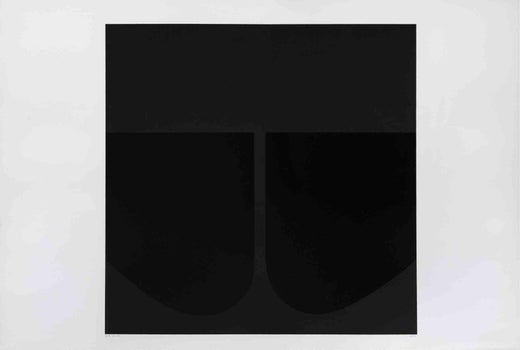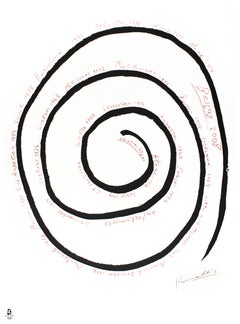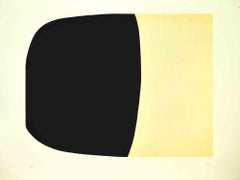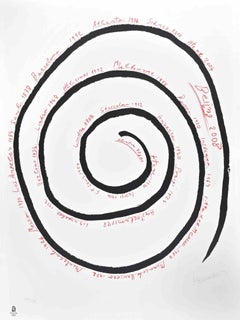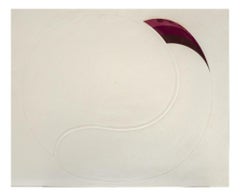Want more images or videos?
Request additional images or videos from the seller
1 of 7
Alberto BurriCretto Nero D - etching and aquatint with embossing By Alberto Burri - 19711971
1971
Price:$11,492.25
$16,744.49List Price
About the Item
- Creator:Alberto Burri (1915-1995, Italian)
- Creation Year:1971
- Dimensions:Height: 26.78 in (68 cm)Width: 37.8 in (96 cm)Depth: 1.58 in (4 cm)
- Medium:
- Movement & Style:
- Period:
- Framing:Framing Options Available
- Condition:Insurance may be requested by customers as additional service, contact us for more information.
- Gallery Location:Roma, IT
- Reference Number:Seller: T-1431391stDibs: LU650313309512
Alberto Burri
Alberto Burri was born in a small town in Umbria, Italy, called Città di Castello. At the age of 25 he graduated with a degree in medicine from Università degli Studi di Perugia. He served as a physician in World War II, where his unit was captured in Tunisia in May 1943 and imprisoned in a prisoner-of-war camp in Texas. Following his release, Burri abandoned medicine and never practiced again. Instead, he took up painting.
Burri set up his first studio in Rome following his repatriation to Italy in 1946. His first solo exhibition was at the Galleria La Margherita in 1947. Burri exhibited with the Rome Art Club and was influenced by the growing Futurist use of multi-material art among his Italian contemporaries. Growing in popularity for his experimental use of pigment and resin - as well as his incorporation of burlap bags and household linens to make his famous Sacchi (sacks) and Bianchi (whites) – Burri began to exhibit in the United States from 1953. His fist exhibition in the USA was at the Allan Frumkin Gallery, Chicago, and the Stable Gallery in New York. Burri’s incorporation of raw material into his art pushed the boundaries between painting and sculpture. His ingenuity only increased over time, and there seemed to be no distinction between artistic materials and simply materials that he harnessed and moulded into art. He developed unprecedented techniques such as painting with combustion to make torched wood veneer works (Legni). steel (Ferri) and overlays of melted and charred plastic (Combustoioni Plastiche).
From 1963-1991 Burri spent the winters in Los Angeles with his wife, American dancer Minsa Craig. Here, Burri ventured into Minimalism, painting black and white fields of induced craquelure that make up his famed Cretti monochromatic collection. His Grande Cretto (1985-89) is of course at the heart of this moment as a Land art work built over the ruins of Gibellina, the Sicilian town destroyed by the Belice earthquake sequence. In 1978, Burri designed his own museum in his birth town’s Palazzo Albizzini, which opened in 1981, with works from his last series, the Cellotex, on permanent display from 1990. Since Burri’s death in 1995, in Nice, France, Burri has been the subject of many retrospectives, most notably Alberto Burri: The Trauma of Painting at the Solomon R. Guggenheim Museum (2015-2016). His work is held at the Tate, Museum of Modern Art (MoMA), San Francisco Museum of Modern Art and has been included at the Venice Biennale International Exhibitions and the Biennale de Lyon.
About the Seller
4.9
Platinum Seller
Premium sellers with a 4.7+ rating and 24-hour response times
1stDibs seller since 2017
7,719 sales on 1stDibs
Typical response time: 2 hours
Authenticity Guarantee
In the unlikely event there’s an issue with an item’s authenticity, contact us within 1 year for a full refund. DetailsMoney-Back Guarantee
If your item is not as described, is damaged in transit, or does not arrive, contact us within 7 days for a full refund. Details24-Hour Cancellation
You have a 24-hour grace period in which to reconsider your purchase, with no questions asked.Vetted Professional Sellers
Our world-class sellers must adhere to strict standards for service and quality, maintaining the integrity of our listings.Price-Match Guarantee
If you find that a seller listed the same item for a lower price elsewhere, we’ll match it.Trusted Global Delivery
Our best-in-class carrier network provides specialized shipping options worldwide, including custom delivery.You May Also Like
The Dayton's Bag: Two original abstract lithographs plate signed double sided
By Frank Stella
Located in New York, NY
Frank Stella
The Dayton's Bag, 1984
Two (2) separate offset lithographs: one on each side of a mixed media paper shopping bag
18 1/2 × 16 × 4 inches
Plate signed "Frank Stella '84" twice: once on each side of the bag (see photos)
This paper shopping bag with two different color offset lithographs (one on each side) was created by Frank Stella along with his longtime publisher Tyler Graphics. The work is plate signed Frank Stella on the top of each side, and each side bears the printed text, "Dayton's Salutes the Opening of Walker Art Center's New Galleries. Premiere Exhibition Selections from Tyler Graphics, 23 September '84 to 17 May '85." This elegant work, produced with the highest quality lithography by Frank Stella at Tyler Graphics, was created in a limited quantity solely for VIP collectors at that one day's event as it was a true one-off creation. Not too many of them have survived a quarter century on, and rarely in such good condition. Not too many people you know can boast that they possess a Frank Stella shopping bag.
Note that this listing is for one two sided shopping bag, each side with a different color lithograph - so it's actually two Frank Stella lithographs...
Category
1980s Abstract Expressionist Abstract Prints
Materials
Mixed Media, Lithograph, Offset
$1,500
H 18.5 in W 16 in D 4 in
Cascade (Fine bone china plate, new in bespoke box, Limited Edition of 175)
By Loie Hollowell
Located in New York, NY
Loie Hollowell
Cascade, for Coalition for the Homeless, 2020
Fine bone china in red gift box
10 3/4 in diameter
Edition of 175
Signed in plate, Artists ...
Category
2010s Abstract Abstract Prints
Materials
Porcelain, Screen, Mixed Media, Board
$1,000
H 10.75 in Dm 10.75 in
Beauty for Sale, monotype (unique) signed by contemporary abstract artist
By Andrea Belag
Located in New York, NY
Andrea Belag
Beauty for Sale, 1990
Monotype on cotton rag paper
42 1/2 × 30 inches
Unframed
Pencil signed, dated and titled on the front; bears publisher name and copyright on the back
Exquisite monotype; both gestural and minimalist. The title speaks for itself and defines the work.
American painter Andrea Belag creates lush and luminous abstractions inspired by the visual and spiritual principles of Zen, as well as artists such as Mary Heilmann, Bernard Frize...
Category
1990s Abstract Abstract Prints
Materials
Monotype, Mixed Media, Pencil, Graphite, Lithograph
$2,800
H 42.5 in W 30 in
Rainbow Signed/N 1970s silkscreen & lithograph, pioneering female Fluxus artist
By Mary Bauermeister
Located in New York, NY
Mary Bauermeister
Rainbow, 1973
Lithograph and silkscreen on creamy white paper
Hand signed, dated and numbered 56/250 by the artist on the front
19 x 25.5 inches
Unframed
This work is on the permanent collection of various institutions like: Rice University, Samuel Dorksy Museum of Art, Rutgers Zimmerli Museum and Wheaton College Massachusetts.
While studying the fringe sciences the 1970s, Bauermeister created Rainbow (1973), a lithograph and silkscreen. She uses a creamy white background as the base. Two intersecting diagonal bands of color transcend across the page, and black cursive lettering dances over the surface serving as a mind map of interweaving ideas. Through the central band, Bauermeister shifts through the color spectrum; she begins with red and finishes with violet. Inspired by music, she uses strokes of color that are rhythmically smeared across the lithograph.
The surface lettering, a kind of visual poetry, explores her interest in human emotion and science. The viewer can see Bauermeister’s thoughts as they flow into one another through the use of words such as bliss, love, and healing. Bauermeister also includes a repetition of words such as cancer, sickness, and cure. The word cancer emerges from a cell-like shape. A careful study of the words shows that they may seem dark in nature; however, she juxtaposes these words against the cheerful title and colors. Perhaps the rainbow symbolizes a new hope, an inspiration for an optimistic future.
-Courtesy to the Samuel Dorsky Museum of Art
About Mary Bauermeister:
A multidisciplinary artist known for her intricate and enigmatic assemblages, Mary Bauermeister (1934-2023) continues to defy categorization with layered works in a range of media. A precursory figure of the Fluxus movement—her studio was the meeting point for a number of defining artists of the avant-garde—her work plays an integral role in the discussion of art, both European and American, that emerged from the 1960s. Her reliefs and sculptures, which have incorporated drawing, text, found objects, natural materials and fabric, reference a plethora of concepts: from natural phenomena and astronomy to mathematics and language, as well as her own “spiritual-metaphysical experiences.” Maturing amidst the currents of Minimalism and Pop Art, Bauermeister’s art has resisted labels due to the singular expression of her interests and concerns, among them the simultaneous transience and permanence of the natural world with experimentations in transparency and magnification, multiplication and variation, structure and order, chance and ephemerality, introversion and extroversion. Her three-dimensional receptacles of thoughts, ideas, and notes contain visual, conceptual, and philosophical paradoxes that challenge perceptions and that offer literal and metaphorical windows into which one can glimpse the inner workings of the artist’s mind.
- Courtesy of Michael Rosenfeld...
Category
1970s Abstract Abstract Prints
Materials
Lithograph, Screen, Mixed Media
Seven from Logo Suite (Pink Blue) - 3D signed mixed media multiple #65/100
By Richard Smith
Located in New York, NY
Richard Smith
Seven from Logo Suite (Pink Blue), 1971
Silkscreen on 3-D Molded Plastic Over Wood
Pencil signed, dated and numbered 65 from the edition of 75 on the front
23 1/2 × 19 ...
Category
1970s Abstract Geometric Mixed Media
Materials
Plastic, Wood, Mixed Media, Screen
$2,000
H 23.5 in W 19.5 in D 3 in
Doric (Hand signed by Sean Scully)
By Sean Scully
Located in New York, NY
Sean Scully
Doric (Hand signed by Sean Scully), 2012
Hardback monograph (hand signed by Sean Scully on the title page)
Hand signed by Sean Scully for the present owner at a special ...
Category
2010s Abstract More Art
Materials
Mixed Media, Permanent Marker, Lithograph, Offset
Frank Stella; An Illustrated Biography (Hand signed and dated by Frank Stella)
By Frank Stella
Located in New York, NY
Frank Stella; An Illustrated Biography (Hand signed and dated by Frank Stella), 1995
Hardback monograph (hand signed and inscribed on the title page)
Hand signed and dated by Frank Stella on the title page
12 1/4 × 9 1/2 × 1 inches
Unframed
This lavish First Edition 1995 hardback monograph is hand signed and dated by Frank Stella on the title page. Makes an excellent gift.
Publisher's Blurb:
A friend and colleague of Frank Stella's for forty years, Sidney Guberman presents a unique view of this seminal figure of contemporary American art...
Category
1990s Abstract Expressionist More Art
Materials
Mixed Media, Lithograph, Offset
$1,200
H 12.25 in W 9.5 in D 1 in
Limited Edition Monograph: Pat Steir (Hand signed and inscribed by Pat Steir)
By Pat Steir
Located in New York, NY
Pat Steir (Hand signed and inscribed by Pat Steir), 2014
Limited Edition clothbound hardback monograph with no dust jacket as issued (hand signed and inscribed to Nadine)
Hand signed...
Category
2010s Abstract Abstract Prints
Materials
Paper, Ink, Mixed Media, Lithograph, Offset, Board
$750
H 13 in W 10 in D 0.75 in
Monograph: Anish Kapoor (Hand signed and inscribed to Nadine by Anish Kapoor)
By Anish Kapoor
Located in New York, NY
Anish Kapoor
Anish Kapoor (Hand signed and inscribed to Nadine by Anish Kapoor), 1998
Hardback monograph (Hand signed and inscribed to Nadine by Anish Kapoor)
Hand signed and inscri...
Category
1990s Abstract Abstract Prints
Materials
Paper, Ink, Mixed Media, Lithograph, Offset
$1,000
H 8.75 in W 8.75 in D 0.5 in
Hardback monograph of renowned sculptor: TROVA (hand signed by Ernest Trova)
By Ernest Trova
Located in New York, NY
Ernest Tino Trova
TROVA (hand signed by Ernest Trova), 1978
Hardback monograph with dust jacket (hand signed by Ernest Trova)
Hand signed by Ernest Trova on the half title page
11 × ...
Category
1970s Abstract Abstract Prints
Materials
Paper, Ink, Mixed Media, Lithograph, Offset
$500
H 11 in W 11.5 in D 2 in
More From This Seller
View AllNever-Ending Spiral - Mixed Media by Jannis Kounellis - 2008
By Jannis Kounellis
Located in Roma, IT
Lithograph realized by Yannis Kounellis in occasion of the Olympic Games of Beijing, China, in 2008.
Hand signed and numbered, perfect condition.
This work is from the portfolio Th...
Category
Early 2000s Abstract Abstract Prints
Materials
Mixed Media
Bianchi e Neri II (Acetates) - Plate B - By Alberto Burri - 1969
By Alberto Burri
Located in Roma, IT
Bianchi e Neri II (Acetates) - Plate B is a wonderful Contemporary artwork realized by Alberto Burri in 1969.
Hand-signed in pencil on the lower right margin
Hand-numbered in pen...
Category
1960s Abstract Abstract Prints
Materials
Mixed Media
Never-Ending Spiral - Mixed Media by Jannis Kounellis - 2008
By Jannis Kounellis
Located in Roma, IT
Never-Ending Spiral is a mixed media print realized by Jannis Kounellis.
Limited edition of 260.
Hand signed and numbered.
This artwork is from the portfolio The Unique Collectio...
Category
Early 2000s Abstract Abstract Prints
Materials
Mixed Media
White Ball - Original Mixed Media by Shu Takahashi - 1973
By Shu Takahashi
Located in Roma, IT
White Ball is an abstract silk-screen and copperplate engraving print on heavy paper, realized in 1973 by the Japanese artist Shu Takahashi.
Not numbered and not signed.
Good condi...
Category
1970s Abstract Abstract Prints
Materials
Mixed Media
Partitura per 8 Tempi - Screen Print by Marco Gastini - 1999
By Marco Gastini 1
Located in Roma, IT
Hand Signed.
Edition of 90 copies.
Original paper wallet and CD included.
Category
1990s Abstract Abstract Prints
Materials
Screen, Mixed Media
Turquoise Ball - Mixed Media by Shu Takahashi - 1973
By Shu Takahashi
Located in Roma, IT
Turquoise Ball is an abstract silk-screen and copperplate engraving print on heavy paper, realized in 1973 by the Japanese artist Shu Takahashi.
Not signed and not numbered
Good co...
Category
1970s Abstract Abstract Prints
Materials
Mixed Media
Recently Viewed
View AllMore Ways To Browse
Joan Miro Album 19
L Stanley
La Grenouille
Le Lezard Aux Plumes
Louise Bourgeois Lithograph
Marcel Mouly Signed
Miro Le Lezard
Motherwell Elegy
Richard Hunt Lithograph
Richard Hunt Prints
Signed Calder Print
Silvio Zamorani
Sue Fuller
Willem Sandberg
Yaacov Agam Serigraph
Agam Lenticular
Alexander Calder Print Signed
Andre Masson Original Lithograph
